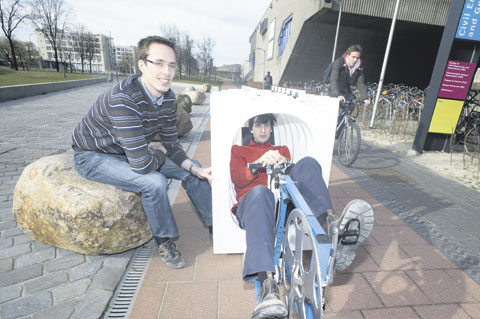Last week Human Power Team Delft presented its design for what is to become the fastest bicycle on Earth and beyond. “Our main advantage is the aerodynamics.”
The holder of the current world record speed for a human-powered vehicle is a Canadian, Sam Whittingham, who on 18 September 2009 reached the incredible speed of 133 kilometres per hour at Battle Mountain, Nevada, riding his Varna Tempest, which was designed and built by Georgi Georgiev. A YouTube clip shows his dagger-shaped bike flashing past. It’s hard to imagine how anyone can hope to improve on Georgiev’s creation.
“Our main advantage is the aerodynamics of the hull,” says David Wielemaker, an aerospace engineering student and designer for the Human Power Team Delft (HPT). Georgiev’s approach is craftsmanship: he shapes the hull by hand from a block of synthetics. The Delft students use computer programmes to calculate the drag and windtunnel models to verify their design. Over the course of a couple weeks Wielemaker digitally bent and reshaped the hull in 30 iterations to arrive at the present form, which, according to calculations, will experience 20 to 30 percent less drag at top speed, even though its frontal surface is larger than Varna’s.
“It’s a trade-off in design,” Wielemaker says. “Either you make a small hull for a smaller guy, or you make it larger to accommodate a more bulky driver. We choose the latter, because power increases more than drag.”
Last week the team presented their two candidate drivers for the speed record: Sebastiaan Bowier (2nd place at Dutch championships for recumbent bikes) and Jan Willem Gabriels, who rowed in the Holland Eight in the 2004 Athen Olympics. “Two meters tall and hundred kilograms of muscles,” says HPT project leader, Hajo
Pereboom, who studies mechanical engineering. Power tests by sports science students at VU University Amsterdam have revealed impressive results: the athletes yield 700 to 800 Watts in 30 seconds, which equals one horse power! And that’s about seven times more than the average cyclists put on his pedals.
The main visible difference from the Varna is the absence of a canopy: the window is in front of the driver’s feet. One also notes the wheel housing, which has better aerodynamics, and the large front wheel that reduces the rolling drag. The rear wheel has been kept small to limit the overall length.
Naam: Edwin de Vries (21, TB)
Dreamteam: Delta Lloyd Solar Boat Team (deltalloydsolarboat.nl)
Functie: Team manager
Alle begin is moeilijk, kan Edwin de Vries beamen. Samen met zijn team wil hij de Frisian Solar Challenge 2010 winnen. “We hebben inmiddels veel sponsoring, tijdens de race hebben we zelfs een vloot auto’s om de boot te volgen.” Dat was in het begin wel anders. “Ik heb in maart een plek op watersportbeurs Hiswa geregeld, om publiciteit en sponsors te werven. Alleen moest de boot daar aantrekkelijk gepresenteerd worden. En de beurs was al een week later.” De boot stond nog op een aftands frame. “Functioneel, maar het zag er niet uit.”
Besloten werd zelf een mooi frame te bouwen. “Een plank van tweeënhalve meter op de fiets vervoeren is geen goed plan”, weet hij inmiddels. “Die plank is wel honderd keer op de grond gevallen op weg van de Gamma naar de TU, en mijn handen lagen open.” Een zaag en een likje witte verf zorgden uiteindelijk voor twee mooie pilaren om de boot uit te stallen. “Een snelle, low budget oplossing, maar het zag er goed uit. En, dat mag ook wel, voor zo’n hightech zonneboot.”



Comments are closed.